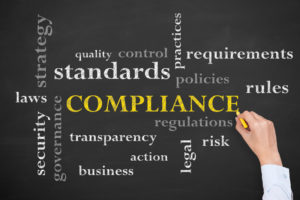Digital accessibility compliance is appearing in the news more and more. 2020’s new normal of working from home has brought this even further into the attention of the public. It has never been more pressing for your organization to provide digital information to everyone, both internally and externally.
Here are four reasons why you need to make digital accessibility compliance a priority.
1. It’s the Law
Whether your organization is a private enterprise, a school, a government entity, or a nonprofit, there is some law requiring digital accessibility compliance.
Federal Law
Federal law addresses accessibility with the American’s with Disabilities Act (ADA). The ADA says that no organization can discriminate against a person based on their disability. Many federal cases have referred to this legislation when addressing digital accessibility lawsuits. These lawsuits have been on the rise over the last few years, and continue to be in the news regularly.
Section 508 of the Rehabilitation Act also prohibits discrimination, applying specifically to schools and government agencies. It applies to any organization that receives federal funding and requires digital accessibility compliance with its specific guidelines.
State Laws
Additionally, many states have their own digital accessibility compliance legislation and guidelines. It’s important to be aware of the laws that apply to your organization to ensure your compliance. As a rule of thumb, adhering to Web Content Accessibility Guidelines (WCAG) means you are likely compliant with other standards for digital accessibility compliance. WCAG is the gold standard for digital accessibility for many countries around the world, and it is referred to in a number of settlements and decisions for digital accessibility lawsuits.
International Law
Digital accessibility compliance is also required if you want to do business with many countries outside the US. The European Union (EU), as well as a large number of other countries, have developed their own digital accessibility standards. The United Nations Convention on the Rights of People with Disabilities also recognizes the rights of people with disabilities to full access to information and communications. The World Intellectual Property Organization (WIPO) ratified a treaty that advances the right to read for people with print disabilities. If you wish to do business internationally, you should be sure your digital information is accessible.
2. Lawsuits are Expensive
An inaccessible website means people who use assistive technology (such as screen readers or connected Braille displays) cannot fully access the information on your website or your digital documents. This means you could lose business, receive complaints, and in some cases, face an accessibility lawsuit. Win or lose, a lawsuit is expensive. It costs you in legal fees, court costs, manpower, and time. It disrupts business and can damage your reputation.
The average cost of a digital accessibility compliance lawsuit is $10,000 in lawyer and settlement fees in addition to the lost time and wasted manpower. And this doesn’t include the cost of the website and document remediation, which you will have to do anyway. In most cases, the plaintiff is happy to have the issues corrected. They are not always eligible for damages, aside from the legal fees. But some cases can be far more expensive, such as these two:
Aleeha Dudley vs Miami University
Aleeha Dudley, a student at Miami University of Ohio, was unable to access her classwork because she uses assistive technology to access digital information. The university was required to make its website and materials digitally accessible> This meant they had to develop an accessibility plan, hire a web accessibility coordinator, acquire new software and train their faculty in digital accessibility. Additionally, Dudley was awarded over $100,000 in damages to cover costs associated with transferring schools. Dudley switched to Ohio University to pursue her degree and Miami was required to pay for her tuition, books, plus room and board.
National Federation of the Deaf vs. Netflix
The National Federation of the Deaf sued Netflix for a failing to caption their content in a timely fashion. Netflix must caption new content within 7 days of its appearance on the platform as part of the settlement. The NFD was awarded $755,000 for lawyers’ fees, as well as $40 000 for the decree to be executed over four years.
The majority of cases are settled. But nearly all settled or court-decided digital accessibility lawsuits require the defendant to remediate their website and documents to make them compliant. In those cases, the timeline is not set by the defendant, and this enforced roadmap can add to the costs for remediation if elements of the project have to be rushed. It makes sense to be proactive about digital accessibility compliance and avoid the additional costs that result from a lawsuit.
Digital accessibility compliance isn’t just about avoiding lawsuits. The cost and work required to achieve digital accessibility have real business benefits beyond complying with the law.
3. Increased Revenue

Digital accessibility compliance can result in increased revenue. According to the CDC, as many as 26% of adults have some kind of disability. Making your digital information accessible for everyone, including people who use assistive technology, means you are not excluding the large market share of people who have disabilities. Organizations spend a lot of time and money to increase market share, and accessibility is a great way to be sure you’re not excluding part of your market.
Another bonus is that including elements such as closed captioning, audio and video transcripts, text alternatives for images, and headings, will increase your search engine optimization (SEO) and boost traffic to your website. Search engines use text and metadata on your website to direct their search results, so the more text you include the better your results. When all users can experience your website, there is a lower bounce rate, more conversions, and less negative feedback.
4. Improved Reputation
Having a website that meets digital accessibility compliance requirements also allows your organization to demonstrate its social responsibility. Many organizations are now publishing their accessibility policies and practices. Additionally, an established accessibility culture can be a big draw for prospective employees. A 2018 McKinsey study on diversity showed that companies that embrace diversity are “27% more likely to have superior value creation and 33% more likely to have industry-leading profitability.” People want to work for organizations that demonstrate social responsibility, inclusion, and that are actively against discrimination.
Your customers will be happy to know that your organization is inclusive and that it supports all users equally. Count the negative publicity caused by accessibility lawsuits with the positive impact of word of mouth from your disabled customers. Many people with disabilities happily praise organizations with whom they can easily and independently do business. Additionally, accessibility compliance means your website is more usable for all users – not just those with disabilities. Things like captioning for videos, headings, simple language, and a clean design with fewer distractions make for a better experience for everyone.
Avoid the Risks and Reap the Benefits
Being proactive and inclusive about digital accessibility compliance avoids risk and has some distinct advantages. Digital accessibility compliance helps avoid lawsuits, expensive settlements, and complaints. It also boosts your market share and your SEO, while enhancing your reputation and benefiting all customers, including those with disabilities.
Ready to address accessibility for your organization? Contact us for a free consultation.
For more information, check out these articles:
Digital Accessibility Litigation and How To Avoid It
SEO and Accessibility – Improve One with the Other
ADA, Section 508 & WCAG-Navigating the Rules of Accessibility Legislation
The post 4 Reasons for Digital Accessibility Compliance appeared first on Equidox.





